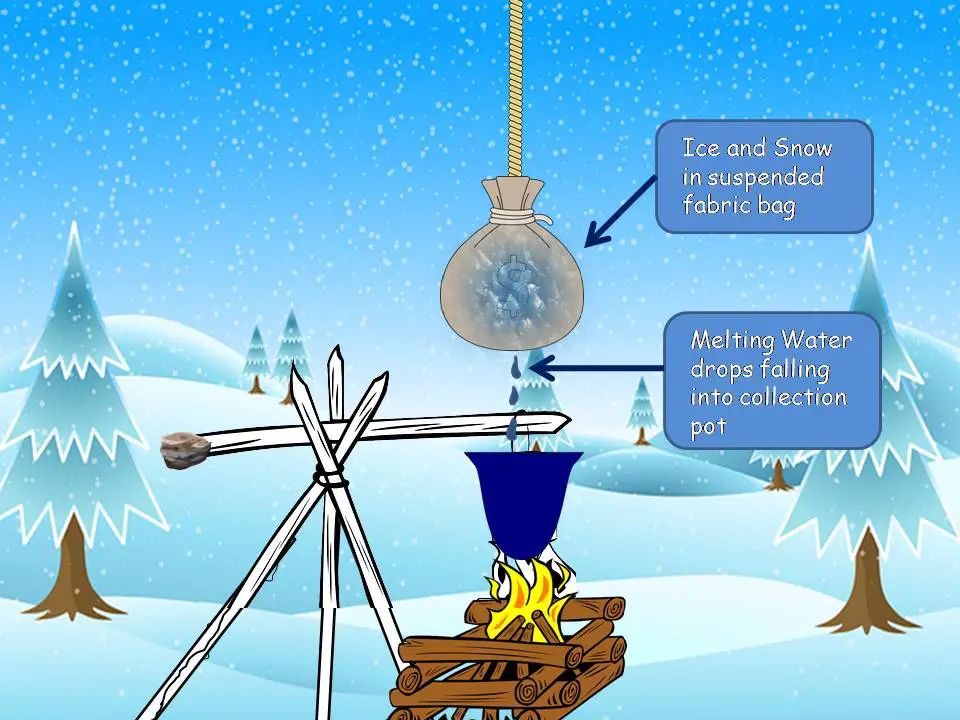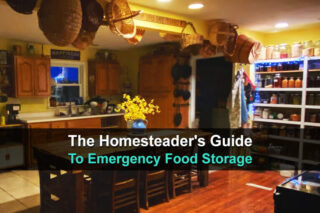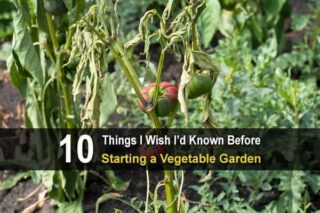Estimated reading time: 11 minutes
We’ll cut to the chase. Collecting snow and ice is sometimes the only option for natural water collection in winter. The rest of the year offers numerous options from harvesting rain to pulling water from springs, creeks and lakes. But in winter, thing get complicated. Lakes and rivers are frozen and rain comes down as snow.
Reasons for Natural Water Harvest
Most people don’t spend lot of time harvesting water from natural resources. However, there are occasions when finding water from other sources is either necessary or desired as an alternative. Here are few situations that make a natural water harvest like snow and ice a good idea.
Want to save this post for later? Click Here to Pin It On Pinterest!
Camping is an obvious situation and a time when collecting water from natural sources is a necessity. We can go weeks without food but only about 3 days without water. In winter, snow and ice may be the only option.
Power outages are another reason for natural water collection and once you’ve drained all the water from the water heater you have to turn to nature for water.
Some people are in luck and the water pressure from municipal water tanks still make it to their homes for a while, but people reliant on a well pump powered by electricity are out of luck. The good news is that even in the city snow and ice will be easy to find.
Off-grid living is another situation where natural water collection is a necessity. Most people pursuing off-grid lifestyles have robust solutions for water collection, but even they are sometimes challenged by winter temperatures. That’s when snow and ice can make things easier.
But It’s Not as Easy as It Sounds
There’s a bit of complexity to getting water from ice and snow. The obvious solution is to collect it and melt it, but where and when you collect ice and snow will have a lot to do with the quality of the water.
Melting down the ice and snow is also harder than some assume and it not only takes time but sustained heat and patience.
The biggest challenge is purifying the water after the snow and ice is melted. In a freezing environment, traditional water filters will often fail due to the fact that the filters get frozen and crystallized. Boiling is the best solution for water purification in winter, but water treatment tablets will also work.
The biggest thing to remember is that freezing does not kill germs. It’s true that freezing temperatures will suspend the growth of bacteria in water, but once the water is thawed they are alive and reproducing.
Snow or Ice –Which is Better?
The simple answer is that ice is better. It’s much denser than snow and melts easier. Snow seems pristine and pure and it can be if it’s freshly fallen snow in a clear, remote environment but snow literally carries a lot of baggage as a water source.
About Snow…
- The first hour or two of a snow fall actually presents the most polluted snow. Snow acts like a scrubbing sponge and collects and traps pollutants in the local atmosphere. As it accumulates so do those pollutants which can include pesticides, soot, particles from exhaust fumes, even mercury and formaldehyde. If it’s in the atmosphere the snow will capture and accumulate it.
- After an hour of two the snow that continues to accumulate is often identified as the purest. What’s important is to collect it as soon as possible. An hour after a snowfall any pollutants in the air will begin to fall to the surface of the snow. A lot depends on where you live, but urban environments produce the most polluted snow.
- Old snow that has melted, thawed and accumulated any matter of pollutants, dirt and particles can still be harvested if that’s all that’s available, but the need for filtering and purifying is all the more important.
About Ice
Ice shows up a few ways in winter. The ice on lakes and ponds is one occurrence but it can be tricky to harvest. An axe or ice auger can work but makes sure you’re working the shoreline. Falling through the ice while wacking it with an axe is a really bad idea.
Icicles are often the ice-form of choice for ice harvest but like so many things in winter, they aren’t as pure as they seem. Here again, a lot depends on your location.
Icicles hanging from rain gutters and the eaves of a roof often appear gleaming and translucent. They are, but that doesn’t mean they’re clean. Icicles melt from the slow accumulation of melting water, usually from a roof, and as they grow they are collecting and concentrating everything that was on the roof.
People who harvest rain from their roof tops are all too familiar with the way that bird droppings on the roof, insects and their droppings, dust, dirt and other particulates all find their way to our roofs. As the icicles form from the melting water all of these things come with it.
It may look crystalline and pure but don’t bet on it. It’s like pulling a ladle of water from a pond or lake and saying, “Looks clean to me.” Most of us wouldn’t make that assumption but a sparkling icicle seems safe.
They’re not, and remember that freezing does not kill germs. Although some experiments with exposing germs to liquid nitrogen and extreme cold seem to work, but who has liquid nitrogen laying around?
Melting Snow and Ice
Heat is the obvious way to melt snow and ice but heat is always a challenge in winter. Anyone camping or living off-grid is going to depend on a campfire, wood-stove or small gas stove for heat or flame, but many people enduring a power outage may be challenged for solutions.
Here are few of the facts that affecting melting snow and ice.
- Snow is harder to melt than ice.
It’s light and airy and if you just throw snow into a pot or pan over a flame you can actually burn the bottom of the pan. The air pockets in snow actually give it some insulating properties that resist melting.
The standard advice is to only add a little snow to the bottom and get a small pool of water before slowly adding more and more snow.
- Starting out with some busted up icicles is a little simpler.
Ice directly exposed to the heat of a pot or pan will melt easier and faster. Ice is also much denser than snow and you will get more water from ice than from the same volume of snow.
- A heated environment is always an option.
If you’re indoors with heat from a stove or other heat source you can gather snow and ice in 5-gallon buckets and simply let it melt over time in a heated house, cabin or tent. It will take time but the average adult needs at least a gallon of water a day just for drinking water, so take advantage of the time and inside temperature. You could also put a pot on the stove top to melt your snow and ice.
- Some camping stoves won’t work.
Propane stoves won’t work when the temperature gets below 15 degrees Fahrenheit. The liquid propane in the cylinders freezes and has to be thawed before use. Melting snow and ice is hard enough without having to thaw a propane cylinder first. If you’re in a location with temperature extremes be forewarned.
- Stoves fueled by gas or white gas are best in winter.
A dual-fuel stove is ideal. These work under pressure using a pump on the tank and will burn in temperatures down to -40 degrees Fahrenheit. They’ll also burn either white gas or regular gas which will not freeze down to -40 degrees.
- The snow and ice in a bag trick.

This snow and ice in a bag trick keeps showing up and it seems a bit complicated. The idea is to collect snow and ice in a fabric bag and suspend it over a fire.
The overall assumption is that you are in a situation where you don’t have a metal pot or can that can endure heat, but some kind of container like a clay pot or bowl that will survive close proximity to a fire and can collect the melted water.
- Use the sun
Snow or ice is collected in a Ziploc bag and placed on a dark surface like a tree stump or black plastic bag. The dark background helps absorb solar radiation and the snow or ice in the bag will slowly melt.
It takes time but if you have no other heat source it works, assuming you have a plastic bag. It seems that you could also put the snow or ice directly into a black plastic bag and get the same result when exposed to the sun.
- Ice on tree branches
Ice can form on tree branches but this is a relatively rare occurrence. The good news is that it may be free of many of the pollutants that trickle down from a rooftop, or coalesce from the surface of a pond or lake. Don’t make any assumption and it’s easy to dip an ice covered tree branch into a pot of boiling water to melt it.
- Don’t eat ice or snow
Kids do it all the time but in a survival situation it’s a bad idea. Eating snow or ice to quench your thirst requires the use of body heat to melt the icicle or snow. It won’t provide near enough water to keep you hydrated and can lead to hypothermia. Find a way to melt it first and then go on to the next step –purification.
Purifying Meltwater from Snow and Ice
Purifying the water from snow and ice is no different than purifying water from any natural source, but winter again complicates things a bit. Here are some solutions and some challenges.
- Traditional water filters may not work
There are portable water filters that are great to have when camping, living off-grid or for emergencies. The potential problem is that the inner filters are made of somewhat delicate membranes that can freeze from a previous use.
If that happens the filter may not work. Keeping the filter in your coat to thaw the filter with body heat is one idea, or some other type of warm environment. If you can’t thaw it you’ll need to pursue alternative solutions.
- Boiling
Boiling water is the best and most obvious water purification solution. It assumes that you have a metal pot or pan and a heat source, but if you can manage it it’s the best solution.
Below 6,000 feet in altitude the water should be boiled for at least one minute. Above 6,000 feet requires 3 minutes. To be safe just boil it for 3 minutes. Boiling over a wood fire also solves the fuel problem you’ll have with any gas stove.
- Water Treatment Tablets
Water treatment tablets are another excellent solution particularly if you don’t have the ability to purify water by boiling over a fire or flame. Just make sure you read the label and use the right amount for the volume of water you’re purifying.
- Ultraviolet Light Purification
There’s a device that uses ultraviolet light to sterilize liquids. It’s small and portable but it requires a certain amount of minerals in the water to work properly. As a result it does not work well with melted snow although It seems to work better with ice from lakes or ponds and sometimes meltwater from icicles.
Water Storage from Snow and Ice
There are multiple water storage solutions depending on the amount of water you’re trying to save. There are a lot of factors affecting water storage but during winter the key is to keep the water from refreezing.
The obvious solution is to store it in an area with a temperature above freezing or you’ll be in a continuous cycle of thawing the stored water. One solution is to store water short-term in a thermos bottle assuming the water is somewhat warm if not hot when poured into the thermos.
Another short-term solution is to store the water in a non-insulated metal bottle and keep it in the pocket of your parka so your body heat can keep if thawed, or next to a fire. Here are some links to articles and videos about water storage and other subjects related to successfully harvesting snow and ice as a water source:
- Survival Water In Winter
- Purifying Water – Filters vs Boiling vs Chemicals.
- Outdoor Water Storage For Cold Weather Climates!!!
- Is Melted Snow Safe to Drink?
- How to Turn Snow & Ice Into Drinkable Water
- Obtaining Water from Snow and Ice
- How to Melt Ice and Snow to Find Drinking Water to Survive
Like this post? Don't Forget to Pin It On Pinterest!
You May Also Like:













There is aggressive weather modification being done using ice nucleation chemicals, aluminum, strontium, barium and other nasty things. Does boiling the water work for today’s snow/ice?